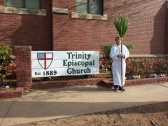What is the usual Sunday worship service at Trinity Church?
Our principal act of worship in the Episcopal Church goes by many names.
In the Episcopal Church today, the most common name for this central act of Christian worship is “The Holy Eucharist.” Eucharist is a Greek word that means “giving thanks.” This reminds us that we are thankful to God for giving us life, for giving us the example of Jesus, and for drawing us into union with him by Christ’s death and resurrection.
What is worship like in the Episcopal Church?
Our worship customs may seem unfamiliar to you if you have not attended the Episcopal Church before. Most of our service comes from the Book of Common Prayer, which has been in use throughout the Anglican Communion in many versions since the year 1549. It may seem strange to you to “say your prayers from a book,” but this allows the whole congregation to join together in worshipping and praising God as one. Just as we can make great poetry or music our own, so we can let the words of our common worship touch our spirits and draw us closer to God and Jesus Christ.
You can find the Book of Common Prayer online here.
If I am visiting, how should I take part in the service?
Our worship may be confusing if you are not familiar with it. The service bulletin which an usher will give you when you enter the church will have instructions about when it is customary to stand,
sit, or kneel. These are suggestions, not commands. Feel free to join in to the parts of the service said by the whole congregation, or not as you prefer.
All persons baptized in any Christian denomination are welcome to receive the Holy Communion with us.
Why do the clergy wear special clothing?
In most worship services, the clergy wear special clothing called vestments. This special clothing is similar to the formal dress of men in the late Roman Empire. The
wearing of vestments reminds us of our connection to the Church of ancient times.
A long tunic, or alb (from the Latin word for “white”) is worn under the other garments. It is belted at the waist with a rope-like cincture. A long, narrow cloth called a stole is worn around the neck. This has been the special “uniform” of the ordained ministry since the fifth century. Over everything is worn the poncho-like chasuble.
Clergy of the Episcopal Church commonly wear the clerical collar. The collar is a “uniform,” that identifies the member of the clergy in public places.
Some Worship Customs of the Episcopal Church
-
The Sign of the Cross: A cross is traced on the body by touching the forehead, lower chest, left shoulder, right shoulder, and the center of the chest. This is made at various times when it is significant to recall Christ’s death and resurrection. The priest makes the “Great Cross” when pronouncing absolution or blessing. When a reading from one of the New Testament gospels is announced, it is customary to make the cross on the forehead, the lips, and over the heart, signifying the desire to have the good news of Christ “in the head, on the lips, and in the heart.”
- Use of Holy Water: There are often small containers of blessed water near the entrance of the church. Some dip a finger into this water and make a sign of the cross, as a reminder that we enter the church through baptism.
-
Receiving Holy Communion: Holy Communion may be received standing or kneeling. For those who have difficulty walking, Communion will be brought to them where they sit. The Bread is customarily placed in the hands of the communicant. Hands are extended flat, with the right hand over the left. Communion may be received by intinction, that is, dipping the wafer of Bread into the chalice. The communicant may do this himself or herself, or may keep the wafer on the hand, and allow the person administering the chalice to dip the Bread and place it on the tongue.









